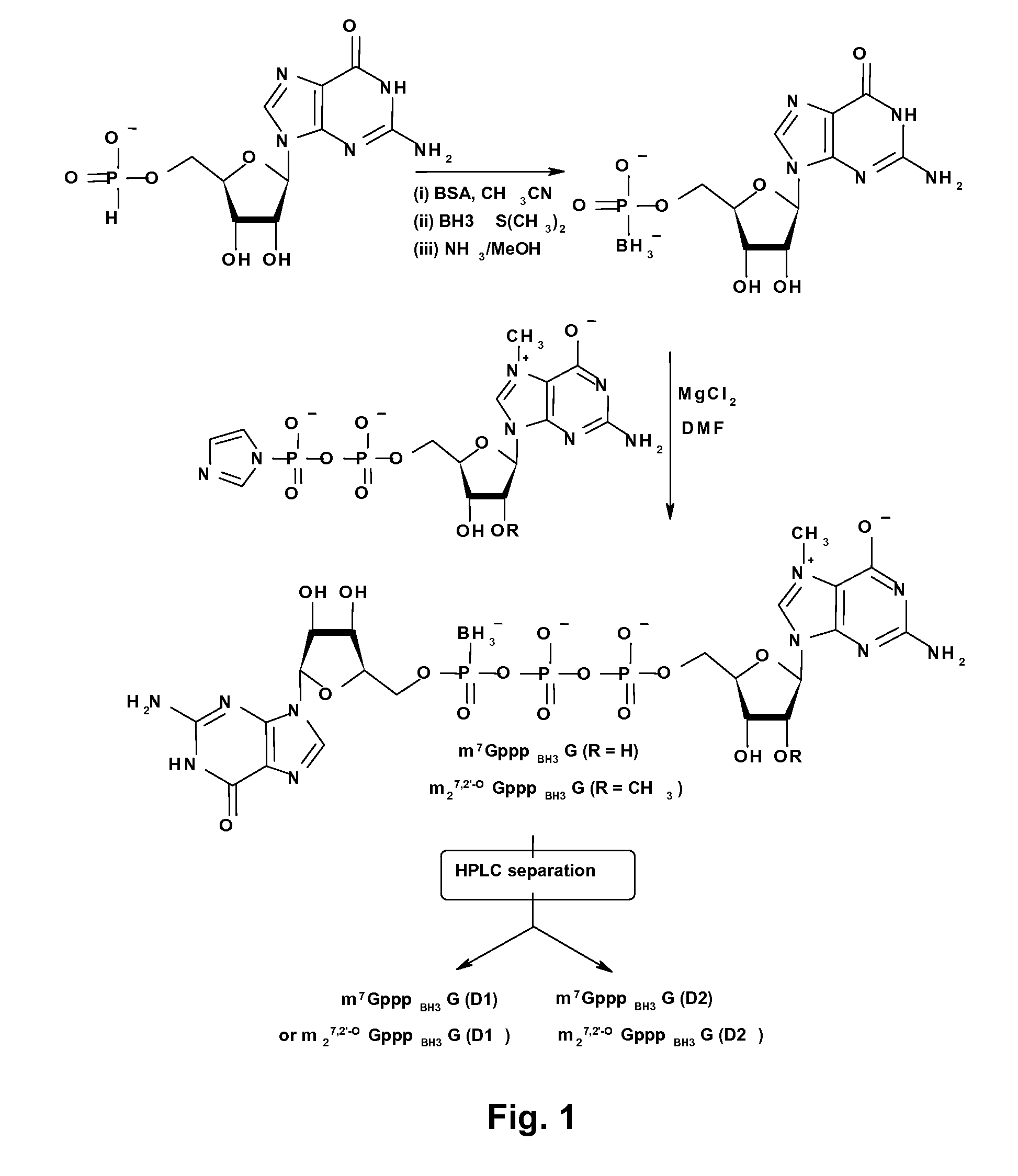mRNA cap analogs
a technology of dinucleotide caps and analogs, which is applied in the field of new dinucleotide cap analogs, can solve the problems of reducing the translational efficiency of synthetic mrna preparations, the limited amount of protein produced from synthetic mrna introduced into cultured mammalian cells by the natural degradation of mrna, and the potential use of cap analogs has never been demonstrated in vivo. achieves the effect of increasing stability in vitr
- Summary
- Abstract
- Description
- Claims
- Application Information
AI Technical Summary
Benefits of technology
Problems solved by technology
Method used
Image
Examples
example 1
General Procedures for Isolation and Characterization of Cap Analogs
[0050]Intermediate nucleotides were separated by ion-exchange chromatography on a DEAE-Sephadex A-25 column (HCO3− form) with a linear gradient of triethylammonium bicarbonate (TEAB) in deionized water. After evaporation under reduced pressure with addition of ethanol, the intermediates were isolated as triethylammonium salts. Final products (the cap analogs) were further separated by semi-preparative RP HPLC and, after repeated freeze-drying, were isolated as ammonium salts. Analytical HPLC was performed on an Agilent Technologies 1200 Series apparatus, using a Supelcosil LC-18-T RP column (4.6×250 mm, flow rate 1.3 ml / min) with a linear gradient of 0%-25% methanol in 0.05 M ammonium acetate buffer (pH 5.9). Eluting compounds were detected with a UV-Vis detector (at 260 nm), and a fluorescence detector (excitation at 280 nm and emission at 337 nm). Semipreparative HPLC was performed on a Waters 600E Multisolvent De...
example 2
General Procedure for Synthesis of Nucleotide Imidazolide Derivatives
[0051]GMP-Im, m27,2′-OGMP-Im, GDP-Im, and m27,2′-OGDP-Im were prepared as described by T. Mukaiyama et al., “Phosphorylation by oxidation-reduction condensation. Preparation of active phosphorylating reagents,”M. Bull. Chem. Soc. Jpn., vol. 44, p. 2284 (1971). The nucleotide (1 equiv., TEA salt), imidazole (8 equiv.), and 2,2′-dithiodipyridine (3 equiv.) were mixed in DMF (˜2.5 ml / 100 mg of nucleotide). Triethylamine (2 equiv.) and triphenylphosphine (3 equiv.) were added, and the mixture was stirred for 6-8 h. The product was precipitated from the reaction mixture with a solution of anhydrous NaClO4 (1 equiv. per negative charge) in dry acetone (˜8 ml per ml of DMF). After cooling at 4° C., the precipitate was filtered, washed repeatedly with cold, dry acetone, and dried in vacuum over P4O10. Yields were 80%-100%.
example 3
Guanosine 5′-(H-phosphonate)
[0052]This preparation followed that of M. Yoshikawa et al., “Studies of phosphorylation. IV. The phosphorylation of nucleosides with phosphorus trihalide,”Bull. Chem. Soc. Jpn., vol. 43, pp. 456-461 (1970). 2′,3′-O,O-isopropylidene guanosine (1.3 g, 4.0 mmol) was suspended in 19.5 ml of trimethylphosphate and cooled to 0° C. on ice. PCl3 (1.06 ml, 12.1 mmol) was added, and the mixture was stirred at 0° C. for 1 h. The reaction mixture was diluted with water (80 ml), adjusted to pH ˜1.5 with solid NaHCO3 and heated to 70° C. for 1 h. The solution was allowed to cool to room temperature, adjusted to pH ˜6 with NaHCO3, diluted with 80 ml of water, and subjected to chromatography on DEAE Sephadex with a 0-0.9 M gradient of TEAB. Fractions eluting at 0.6-0.65 M TEAB and containing ˜3.0 mmol of product were collected, evaporated, and dried in a vacuum dessicator over P2O5. This produced 1.34 g of guanosine 5′-(H-phosphonate) triethylammonium salt (yield 75%). ...
PUM
| Property | Measurement | Unit |
|---|---|---|
| molar ratio | aaaaa | aaaaa |
| molar ratio | aaaaa | aaaaa |
| pH | aaaaa | aaaaa |
Abstract
Description
Claims
Application Information
 Login to View More
Login to View More - R&D
- Intellectual Property
- Life Sciences
- Materials
- Tech Scout
- Unparalleled Data Quality
- Higher Quality Content
- 60% Fewer Hallucinations
Browse by: Latest US Patents, China's latest patents, Technical Efficacy Thesaurus, Application Domain, Technology Topic, Popular Technical Reports.
© 2025 PatSnap. All rights reserved.Legal|Privacy policy|Modern Slavery Act Transparency Statement|Sitemap|About US| Contact US: help@patsnap.com



